Introduction
Today, the international marketplace requires not only a global revelation generally but also the formulation of competitive strategies particularly. Strategic planning specifies factors, which for example, include where a firm has been running for over a year or more, how it runs to reach there and how it will understand if they have achieved there or not. Therefore, different small, medium and giant international ventures are experiencing the necessity to adopt several strategic clues to sustain and develop themselves as competitive ones. Standing on these facts, a number of planning models can be used regarding a number of topic-based and aspiration-based organic scenarios, for instance. Consequently, the formulation of such a plan regarding the international market essentially relies on the form of corporate leadership, cultural aspect, environmental complications, size, and efficiency of plan- makers and so on.
“Think globally, but act locally” should be the soul of any global market player, which wants to be successful while developing its strategic plan like- Asea Brown Boveri as the $25 billion mega venture. Thus, assessing the strategic planning considerations helps to determine the number of benefits regarding the operation of an overseas entity. Such as, it can assist to determine better resource deployment decisions, appropriate strategic direction, formulation of competitive strategies, changing variables of industry, the commitment of geographic and global resources and subsidiary based performance criteria and many more. Thus, the entire analysis will be based on some common factors. Such integral issues can be pointed out as-
- Analyzing the entry strategy used by such a firm while entering into a foreign market;
- Assessing the competitive advantage along with production, sales and other marketing factors;
- Assessing the cultural, internal and other environmental considerations of the firm itself and its selected market;
- It would focus with deep insight on some global market players who are practicing such patterns of strategic options through their international operations in many parts of the world.
Theory of the international market entry evaluation process
This theory of international marketing focuses on 5 stages in order to determine the best global market or markets containing the best scopes for the success of the intended organization (Porter, 2004). Such as
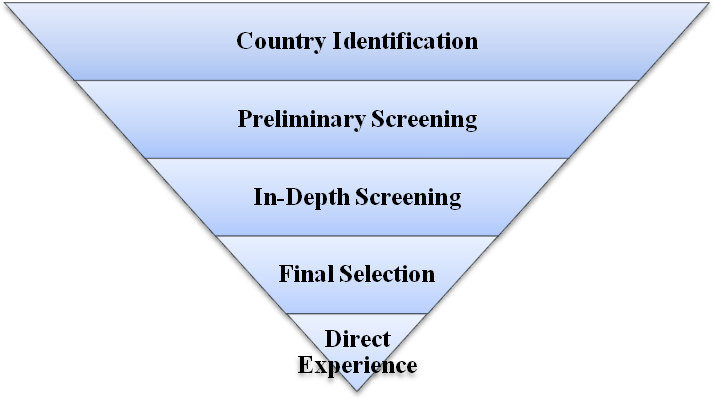
- Country identification: – Any company can prefer any country to enter while identification means undertaking a common knowledge of prospective new markets. Selection is more uncomplicated here. At this early phase, the possible export arena could be involved or excluded for a variety of causes (MTL, 2011).
- Preliminary screening: – Here, a company keeps the soberer emphasis on those nations through the process of preliminary screening. Thus, this stage involves scoring, weighing and ranking countries in terms of macro-economic variables, like- stability of the currency, rate of exchange, the volume of national consumption, etc. Determination of entry constant in a certain market is also important here. So the managers need to select limited zones (MTL, 2011).
- In-depth screening: – At this level, a lot of information is collected on the target market in order to make perfect decisions on marketing. Thus, micro-economic variables are considered along with marketing research regarding 4ps or elements of the marketing mix, like- pricing, distribution, communication programs, adaptation of delivered items, etc. Here, the objective is to determine the STP (segmenting, targeting and positioning) strategy. Additionally, local market valuation, tariffs and scopes or threats for new entrants are also considered (MTL, 2011).
- Final selection: – Here, some limited countries are selected throughout the passage of strategic goals to be equivalent in those countries. Moreover, the organization can consider close contestants or other national entities which have already introduced themselves for the purpose of obtaining firmer market entrance charges. Management can also think of other operating countries for finding out the equivalence or any other lesson which can be applied here. Next, the last soaring, ranking and weighting take place by evaluating more comprehensive issues. And finally, if it is possible, the management should take a chance to have a physical visit to the few selected countries (MTL, 2011).
- Direct experience: – Here, the manager or their agent can have traveled to a particular zone for generating knowledge about its culture and organizational practices. The basic similarities and differences with corporate activities are measured that is followed by self- referencing. It is essential to keep in mind that such personal experience mainly depends on personal life in the home country while the anticipations should follow the knowledge. Flexibility and an experimental attitude are highly essential for intended success (MTL, 2011).
FDI (Foreign Direct Investment)
FDI is also known as Wholly Owned Manufacturing Subsidiary (WOM) which is one of the most popular and common forms of entry strategies in a foreign market (Stanley, 2011). It is a practice, which indicates that the production takes place in the host country through a wholly-owned manufacturing subsidiary, and the company commits investment capital in plant and machinery, which will be at risk in the country. Here, the foreign firm can involve investment in a new manufacturing or assembly plant. So, it basically incorporates taking part in the management, shifting or expertise and technology joint- venture. It can be of two types regarding inward and outward FDI although any sort of investment through the buying of stocks is not considered FDI (Thompson, 2007). The most common forms that FDI may undertake can be listed as follows-
- Through the initiation of WOM;
- Through the acquisition of stocks in the related firm.
- Through taking over or merging of any other firm.
- Through taking part in an equity JV with another firm etc.
Manufacturing FDI poses a number of objectives (Johansson, 2008). Such as-
- the Acquisition of raw materials.
- Operation at lower manufacturing cost.
- Avoidance of tariff barriers as well as the satisfaction of local content requirements.
- Penetration of local markets.
A number of advantages and disadvantages can also be notified (Hitt, Ireland & Hoskisson, 2001). Those are being presented as below-
International strategy of competitive advantage
Organizations that operate across national borders face many of the same competitive challenges as their domestic counterparts. So, through an introduction of competitive advantage, it can blend the elements of multi-domestic and global strategies (Miller, 1998). This can be presented by a framework as follows-
Moreover, international strategies are developed on the decision of the organization for operating competition in each market criteria which have been identified to enter. So, the main comparison variables can be shown below-
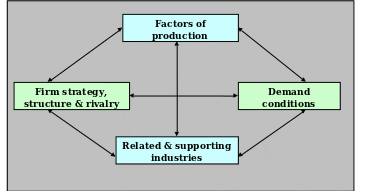
In this regard, Michel Porter’s 4 factors model of competitive advantage for global business can also be mentioned (Griffin, 2006). These are –
- Differentiation: – According to the view of Hitt, Ireland & Hoskisson (2001) and Thompson (2007), this strategy seeks a way to distinguish the company from other competitors through the quality of its products and services. The international entity that can implement this strategy is also able to charge more than others as the customers are willing to pay more value for its quality (Griffin, 2006). Some other aspects are-
- Scale economies in advertising and promotion with a global appeal.
- The capability of drawing upon resources of a coordinated chain of R and D in manufacturing goods.
- Creation of a global network through the stability in service, less emphasis on location.
- Overall cost leadership: – International cost leadership basically means to an integrated set of activities formulated to manufacture goods and services at lower costs than the costs of competitors. Thus, it enables the firm to charge lower prices by still generating profits (Pearce & Robinson, 2006). Other issues are-
- Scale economies can be gained through the centralized manufacturing of standardized goods.
- Copying of inventories can be reduced which may evolve from multiple factories to manufacturing similar goods (Agarwal, Gunavel & Mahindra, 2009)
- Focus: – According to Stoner, Freeman & Gilbert (2006) and (Johnson, Seholes & Whittington (2008), a firm concentrates on a specific local or regional market, line of product or group of customers and so on. It is important while the company wants to use its core competencies of serving a particular product line by emphasizing on the function of light target discriminations from the industry equilibrium point (Johnson, Seholes & Whittington, 2008).
- Integrated cost leadership/ differentiation: – It is a mixture of the major ingredients of differentiation and lower costs. It incorporates flexible manufacturing and sophisticated information channel of TQM with internal and external linkage (Stoner, Freeman & Gilbert, 2006).
Environmental and competitive analysis theory
While formulating a strategic plan from an international perspective, a firm considers various environmental factors since those are significant aspects of macro- marketing variables which affect corporate operations and existence greatly. Several theories can be used to analyze such environmental conditions among which PEST (Political, Legal, Socio-cultural and Technological) analysis is mostly used from an international perspective (Kotler & Armstrong, 2006). It is being described below-
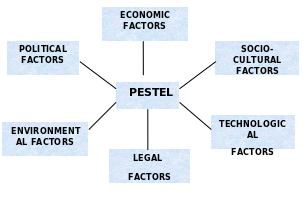
- Political factors: – It involves the stability of political government, foreign government policy regarding trade and market policy, government engagement with various trading agreements, like- NAFTA, SAFTA, EU, ASEAN, etc. (Griffin, 2006).
- Economic factors: – It incorporates deep analysis of foreign market economy for the longer and shorter cycle of time. Additionally, the rate of interest, inflation and employment rate, GDP and GNP, exchange rate fluctuations, etc. are also noticeable (Kotler & Keller, 2006).
- Socio-cultural factors: – It is a highly influential factor for international business which may change from country to country. The sub-factors involve prime religion, the public attitude towards overseas items, the influence of language, participation of men and women in the domestic economy, growth rate of population, age statistics, public ethics, etc. (Kotler & Keller, 2006).
- Technological factors: – Nowadays, technology is being considered one of the most vital organs for achieving competitive advantage. It also incorporates the use of technology for lowering production costs and improving quality, consumption of sophisticated and innovative items, flexible distribution, superior communication with customers, etc. (David, 2008).
Another aspect of environmental analysis encompasses the competitive environment for the company which means the situation faced by the firm within its specific operating arena. The most common tool used for assessing such a competitive environment was developed by Michel Porter, named Porter’s 5 forces model of competition. This theory helps an international market to realize that there are significant competitive forces beyond direct challengers that require/ her attention (Johansson, 2008). This theory is being elaborated below-
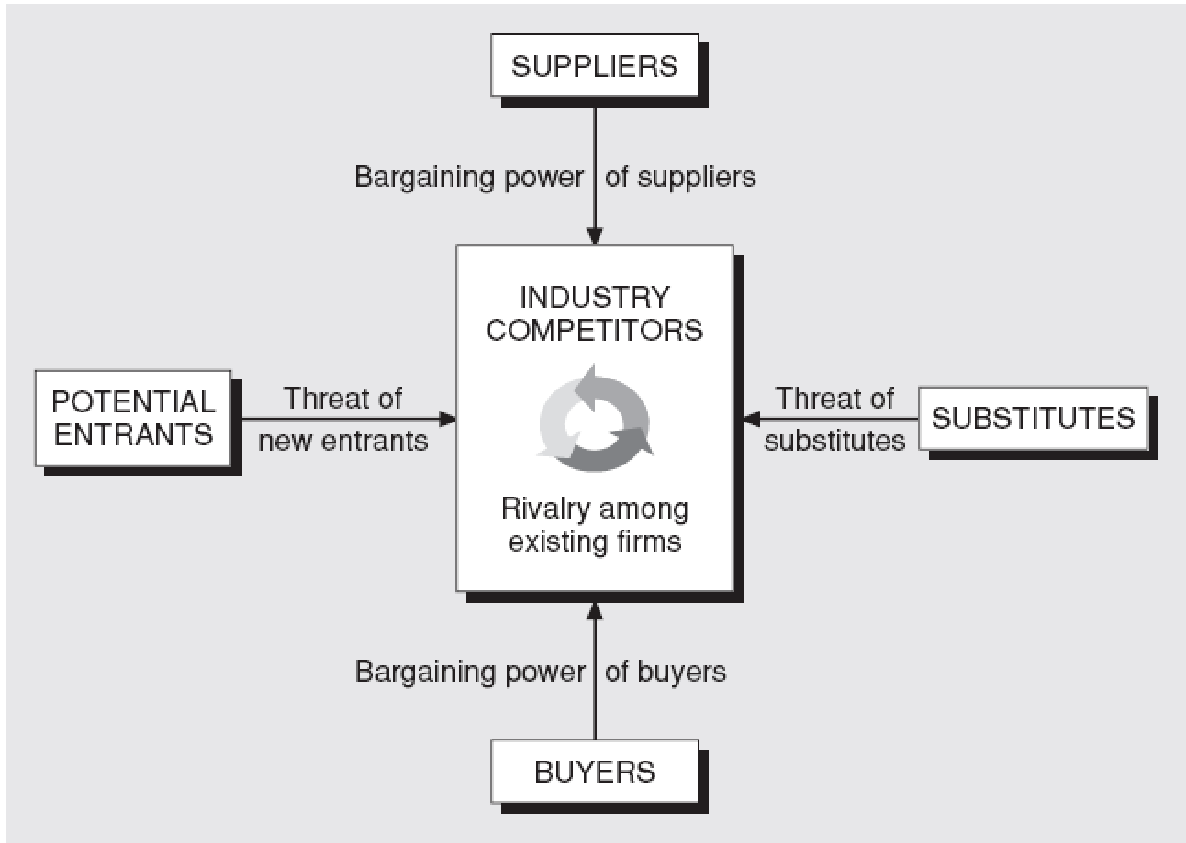
- Threat of new entrants: – When an organization runs in a new market or country, it is said that it has been entered into that market but when it ceases, it is said that it has been exited. As such new entrance creates threats for present firms which are sometimes called incumbents. It also creates new production capability, the probability to erode the market share of other incumbents and importing substantial resources for being successful. So, for the reduction of such threats, present market players may create a number of entry barriers (Stoner, Freeman & Gilbert, 2006). These are-
- Economies of scale- These stay regarding the high-volume firms enjoying lower production costs than the smaller- volume of competitors (Johansson, 2008).
- Experiencing or learning effects- With more volume of production, firms gain experience or lower manufacturing costs per unit (Stoner, Freeman & Gilbert, 2006).
- Cost disadvantages independent of scale- These probably involve proprietary knowledge, like- patents, positive access to raw materials and subsidies by the government, etc.
- Product differentiation- If distinction in physical or perceived natures makes a competitor’s product exclusive to customers, new entrants have to overcome that brand image (Johansson, 2008).
- Others- Other factors include capital requirements, switching costs, anticipated growth and access to distribution channels (Johansson, 2008).
- Bargaining power of suppliers: – Suppliers may have an essential impact on the industry’s revenue potential (Johansson, 2008). The following factors make suppliers more influential-
- Comparatively lack of importance of suppliers than buyers
- Product importance to the buyers
- Greater concentration among suppliers than buyers
- Potential challenge of further integration by suppliers
- High switching costs the customers
- Bargaining power of buyers: – Buyer’s power can be reflected through the reduction of prices, total amount of goods purchased from the industry, demand for advanced quality with similar price or demand for the better terms (Johansson, 2008). Factors making customers more powerful are-
- Undifferentiated inventories
- Challenge for the backward integration of customers
- More focus on buyer’s industry than supplier’s industry
- Price sensitiveness
- Perfect information about supplier’s cost
- Threat of substitute products: – It results in the upper price limit of the market’s goods. Two trends are influential in increasing alternatives involving technological advances and deregulation (Stoner, Freeman & Gilbert, 2006).
- Rivalry among competitors: – Direct rivals means companies selling the same items and intensity is adjusted with the fierceness which these competitors jockey with one another for the competitive situation and better outcome. Thus competitive advantage is commonly used here to attain desired superior position (Johansson, 2008).
Real-world considerations of the strategic plan
The case of Tesco in China
The case of Tesco Plc. in the Chinese market in 2008, March, can be a better example of entering into a foreign market where the company had followed the sequence of the international market entry evaluation process. Here, the company had developed the new form of neighborhood store for the purpose of differentiating itself from other mega competitors, like- Wal- Mart and Carrefour which are highly experienced in the Chinese market by their discount stores and hypermarkets. The company had originally entered this market in 2004 by a 50- 50 JV with a domestic retailer by considering the country’s higher economic growth factor. Localizing is one of the most common mottos used by Tesco to become successful in the Chinese market as the company has been able to deliver extensive selling efforts through 56 hypermarkets at the beginning of 2008 in that region (Tesco Plc, 2008).
From the starting point, it has been utilizing its branded label for above 500 goods involving convenience and pre-packed foods, biscuits, noodles and tissue papers, etc. Furthermore, the company has followed the foremost condition of cultural adaptation by melting some of the strategic elements used in the UK. As it knows that to become successful in the overseas market, knowledge of local culture, customs and habits are necessary, it has been producing products and services according to the need of the Chinese customers through the implementation of a top-down approach. Additionally, it encompasses on use of the local workforce in its management committee. In China, the company is introducing above half of the senior management employees as Chinese people. However, all of their international marketing strategies are not risk-free. According to RNCOS market research, 2005, the Chinese retail sector was worth about $756 billion while Tesco is pertaining only 20% of this market (ICMR, 2011).
The strategic practice of Apple computer
Currently, the renowned PC companies are symbolizing themselves as great adopters of comprehensive managerial strategies. For example, the Apple computer started the PC revolution between 1970 and 1980 through the introduction of the Apple II and Macintosh (Apple Inc, 2009). With such a distinctive product line, the company is now globally well recognized for its innovative approach to the OSX operating system, award-winning computers, and professional and life functions. Additionally, the fashionable Apple items include the iPod as portable music and video player, iPhone as a mobile phone and iTunes as online store. Again, it has created a linkage of its MP3 system with AT and T that has attracted so many recent users. For gaining a competitive advantage, Apple tends to emphasize both external and internal leverages. For instance, it maintains concentrated marketing with product differentiation while it has adopted the strategy of generating single, dynamic and modern phones regardless of the common trend of more production, and less design. Three major internal advantages include brand name, user-friendly interface and sophisticated technology associated with design (Agarwal, Gunavel & Mahindra, 2009). Such as-
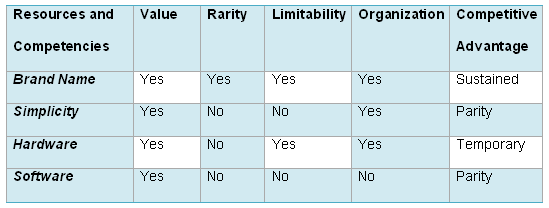
In the short global market strategic framework of Apple induce some common considerations, such as –
- It always eager to develop its Smartphone technology;
- Availability of updates;
- This company is careful to select suppliers;
- On the other hand, it ensures online facilities over the competitors;
- Niche marketing
- In addition, this has control over prices and so on.
The strategic move of Dell computer
According to the annual report of Dell 2010, Dell computer is another significant partner of the global PC market, which was able to establish such market position because of some selective strategic formulation, those are –
- Build- to- order production system: Laptop and desktop purchasers order according to their requirements regarding the speed of the microprocessor, RAM, CD- ROM drive, the capability of hard disk, speakers, size and other related factors. Then, those orders are transmitted to the closest plant. This build-to-order, direct selling indicates that the company has no ready-made finished stock of inventory as its other counterparts in the marketplace (Brunet, 2006).
- JIT delivery system: Dell maintains a long-run relationship with its global vendors which enables it to run on Just-in-time delivery (Brunet, 2006).
- Direct selling: For this issue, the company handles thousands of phone calls and fax orders per day which results in $35 million of online sales daily. Through such practice of direct selling, Dell regularly keeps a connection between buyers and field salespeople that yields in detecting a slight change in demand, the flow of sales and instant feedback about the goods. For the selling approach, Europe has become the largest market for Dell in terms of higher market shares and revenues. Through the cutting down of intermediaries, it can now contact mega customers, like- China (Brunet, 2006).
- Customer service and technical support: The company offers free on-site service globally where it contacts its local partners who repair or handle customer complaints day after posting. Furthermore, it has formed full customized, password-oriented websites, also known as Premier Pages for 40000 organizational, institutional and governmental buyers globally (Brunet, 2006).
There are some other internet-based technical assistive tools (Brunet, 2006). That are-
- Support.Dell.com
- Dell Talk
- Ask Dudley
- E- Support etc.
Amway situation in China
The USA-based Amway company had entered China as a part of their international expansion to over 80 nations with general guidelines of innovative corporate scope and reliance on person-to-person marketing. After considering the integral environmental analysis, Amway had begun to manufacture standard goods for meeting customer demand in the Philippines, Japan, Singapore and Japan and China while its product assortment may be imperfect for the last one. This market is not the mirror views of others as the door-to-door sales strategy along with “party programs” are not adjustable to the culture of the country. Additionally, a direct selling strategy may not be perfect for this country all the time, rather, it would lack legitimacy and could become the subject of government banning. Here, the company would have to alternate its strategic business plan by reformulating the distribution route accompanied with a condition of retail selling only. The more serious issue is this company is facing a strong cultural gap, which hinders it to be fit in the Chinese market (Niant, 2006).
The competitive scenario of Toyota
In the light of Porter’s competitive model, the strategic condition of Toyota, as the famous global automaker can be explained as below-
- In the rising market with high population growth like- China and India, Toyota is facing intense competitive pressure from local car producers as the local government tends to assists those domestic partners for ethnocentrism (Toyota Corporation, 2009).
- According to the annual report 2009 of Toyota, auto manufacturing suppliers are normally raw materials firms while the power of this party varies from region to region. In China, it varies on the basis of price and quality.
- Because of the current global recession, the power of global car purchasers has been increased dramatically by creating pressure on Toyota’s operations (Toyota Corporation, 2009).
- Since the Chinese market poses a number of other direct vendors, the company has to suffer intense competitive pressure from substitute transport including buses, public transport, railways, bicycles, trams and etc. (Annual report, 2009).
- Since the international automobile sector is fully matured with multiple offerings, Toyota today has to sustain a lot of small, medium and giant competitors in China. The foremost potential rivals of the firm involve GM, Honda, Ford, BMW and Landrover, etc. (Toyota Corporation, 2009).
FDI perspective of BMW
The German sporty automobile venture BMW had undertaken the US-based production view of its Z3 model by launching such a plant in 1994. The company had invested $1.4 billion in that facility with 3500 associates which are generally known as Spartangburg plant. Although BMW is completely a German brand, its SUV idea is perfectly American. According to the purpose of making foreign investment in the USA, BMW considers a number of factors regarding ready reach to a big market, low tariff barrier and higher logistical support. Moreover, the company had realized that the local vendors are more active and flexible than their European partners with better adaptation capacity of JIT and supply network. For all of those reasons, during the last ten years, BMW had gained 3-time local customers. Finally, it has been able to create an international sales record in 2001 (Johansson, 2008).
Marketing magic of Euro Disney
Only after a year and a half after revealing its gates in 1992, the Euro Disney theme park, situated outside Paris, was reeling to be bankruptcy. Although the company would take financial help from Walt Disney and other banks to lessen its monetary disasters, it had to be closed because of a number of wrong considerations in its global strategic plan (Johansson, 2008). Such as-
- First, The Company had equally followed its success variables in Japan and North America while in reality park attendance was below expectation and people did not spend much. It had developed excessive hotel rooms which were booked less than the desire of the park.
- Second, its internal strategy specially treating the employees through personal grooming make-up and clothing patterns was not positively adopted by the French employees as they took that as an invasion of privacy and hitting of prestige.
- Third, as the French prefer wine with lunch, it had lost its no-alcohol policy. Time distance and taste regarding the food habit of Americans and French also created a conflict in which Disney had to invest more.
- Finally, the name Euro Disney created the biggest problem.
To remove all of those negative consequences, the theme park has adopted several changing strategies. It has altered its name as Disneyland Paris by adopting a victorious film by Victor Hugo’s termed The Hunchback of Notre Dame as a formal Disney Cartoon. Along with this success, the park had also modified its restaurants and menus in the Parisian way with true French wines at upward prices. The result of such efforts has come into positive impact with some profit potential although experts believe that still now; it is not completely escaped from risk (Johansson, 2008).
Other corporate cases of competitive advantage
The global retailer, Wal- Mart is a prime example of implementing cost leadership like- Volkswagen. NTT DOCOMO in Japan is applying a differentiation method for its wireless communication network. Finally, Komatsu and Caterpillar are using integrated cost leadership/ differentiation while the former had passed the later image through lower expenses and brand valuation globally (Griffin, 2006).
Recommendations
Up to the overall theoretical discussion and real-life cases, a number of issues can be identified which can be recommended and can act as the instruction arena for the companies. That are-
- Deep environmental consciousness about foreign market diversity should be practiced, especially, the SLEPT factors which must be analyzed by Amway. That means, the company should go after the local culture, like- Avon.
- Companies should effectively find out the perfect market niches.
- Value addition is highly essential in the global market in terms of products, services, personnel and marketing mixes.
- Companies should also be judgmental in the selection of efficient HR as done by Toyota.
- Selection of the right partner is also significant in establishing joint ventures for sustaining and maximizing corporate image and revenue stream.
- There should be better coordination and communication between the overseas concern and home country headquarter for better plan development and implementation.
- Organizations should also be aware to minimize the cultural gap. Moreover, it should not synchronize the culture of one country with another.
- In FDI, product and brand devaluation is a major problem that can be solved by shifting the lower-skill operations overseas by maintaining improved functions at home although organizations can be criticized for this activity.
- Finally, to overcome the confusion about the quality standards of global brands and country-of-origin effects by the local customers, firms should strongly focus on building a favorable brand image and loyalty.
Conclusion
In due course, it can be said that there is no alternative to carefully developing a strategic plan for international operation by considering a number of integral issues ranging from deciding upon entry strategy to customer orientation. All of these tasks are related to broader macro level as well as micro-level factors termed as social, economic, legal, ethical, individual, corporate and public issues. Each of such factors is associated with others while a close inspection of one can affect the potential superiority of another. Various international firms are also emphasizing these practices in various distinctive ways while the ultimate outcomes are reflected either in terms of the extreme success of one’s or moving backward of others. However, continuous improvement feedback programs can be effective to obtain the overall success of most of the global partners.
Reference List
Agarwal, K. Gunavel, S. & Mahindra, C. (2009) Strategy Apple Case- Document Transcript.Web.
Apple Inc. (2009) Annual report 2009 of Apple Inc: Form 10-K. Web.
Brunet, G. (2006) Dell Computer Strategy and Challenges. Web.
David, F. (2008) Strategic Management: Concepts and Cases. 12th ed. London: Prentice-Hall.
Griffin, R. W. (2006) Management. 8th ed. New York: Houghton Mifflin Company.
Hitt, M. A., Ireland, R. D., & Hoskisson, R. E. (2001) Strategic Management. 4th ed. South-Western Thomson Learning.
ICMR (2011) Tesco’s Experience in the Middle kingdom. Web.
Johansson, J. K. (2008) Global Marketing. 4th ed. New Delhi: Tata McGraw- Hill Publishing Company Limited.
Johnson, G. Seholes, K. & Whittington, R. (2008) Exploring Corporate Strategy: Text & Cases. 8th ed. London: FT Prentrice Hall.
Kotler, P. & Armstrong, G. (2006) Principles of Marketing. 11th ed. Prentice-Hall of India Private Limited.
Kotler, P. & Keller, K. L. (2006) Marketing Management. 11th ed. Prentice Hall.
Miller, A. (1998) Strategic Management. 3rd ed. Boston: Irwin McGraw- Hill.
MTL (2011) The International Market Entry Evaluation Process. Web.
Niant (2006) The failure of AMWAY Corp’s marketing strategy in China. Web.
Pearce II, J. A. & Robinson, R. B. (2006) Strategic Management. 8th ed. London: McGraw-Hill.
Porter, M. E. (2004) Competitive Strategy. Export Edition. New York: The Free Press.
Stanley, S. (2011) Foreign Direct Investment (FDI). Web.
Stoner, J. A. F., Freeman, R. E., & Gilbert, D. R. (2006) Management. 6th ed. London: Prentice-Hall.
Tesco Plc. (2008) More than the weekly shop, Annual Report and Financial Statements 2008. Web.
Thompson, A. et al (2007) Strategic Management. 13th ed. New Delhi: Tata McGraw- Hill Publishing Company Limited.
Toyota Corporation (2009) Annual Report 2009: The Right Way Forward. Web.